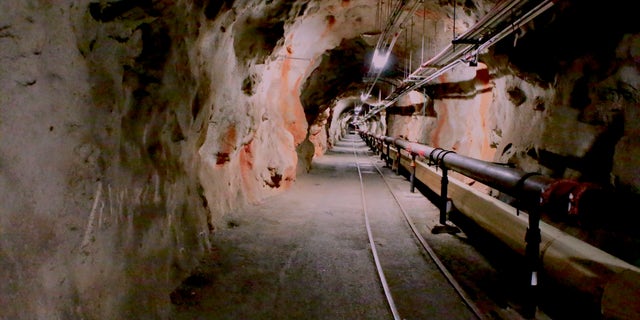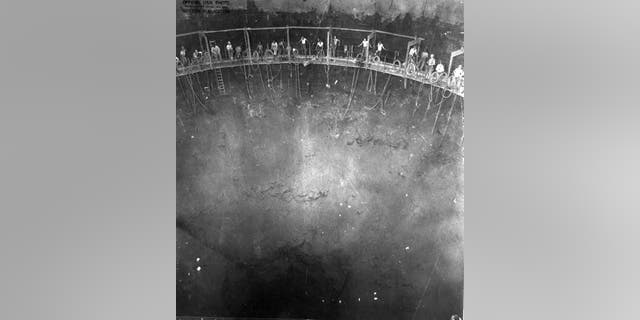NEWYou can now listen to Fox News articles!
The U.S. Navy is planning to defuel Red Hill Bulk Fuel Storage Facility, a massive World War II-era military-run tank farm in the hills above Pearl Harbor, after an investigation revealed multiple mistakes and mismanagement caused fuel to leak into Pearl Harbor’s tap water last year.
The Hawaiʻi Department of Health released the Navy’s investigation on Thursday that found poor management and human error caused fuel to leak from the facility into a well that supplied water to housing and officers in and around Pearl Harbor. Thousands of people were poisoned and military families were forced to evacuate their homes.
FILE – In this Dec. 23, 2021, photo provided by the U.S. Navy, Rear Adm. John Korka, Commander, Naval Facilities Engineering Systems Command (NAVFAC), and Chief of Civil Engineers, leads Navy and civilian water quality recovery experts through the tunnels of the Red Hill Bulk Fuel Storage Facility, near Pearl Harbor, Hawaii. A Navy investigation released Thursday, June 30, 2022 revealed that shoddy management and human error caused fuel to leak into Pearl Harbor’s tap water last year, poisoning thousands of people and forcing military families to evacuate their homes for hotels. The investigation is the first detailed account of how jet fuel from the Red Hill Bulk Fuel Storage Facility, a massive World War II-era military-fun tank farm in the hills above Pearl Harbor, leaked into a well that supplied water to housing and offices in and around Pearl Harbor.
(Mass Communication Specialist 1st Class Luke McCall/U.S. Navy via AP, File)
“Red Hill needs to be shut down as quickly as possible and we fully expect that the Navy will marshal all possible available resources to defuel and decommission the facility,” Deputy Director of Environmental Health Kathleen Ho said in a statement. “However, with the extensive repairs needed and the Navy’s history of spills from unsafe pipelines, our first priority continues to be ensuring that all defueling activities are performed safely for the sake of the people and environment of Hawai‘i.”
The report listed a series of mistakes from May 2021, when operator error caused a pipe to rupture and 21,000 gallons of fuel to spill when it was being transferred between tanks. The fuel spilled into a fire suppression line, sat there for six months and then spilled again when a cart rammed into it in November.
US WORLD WAR II SHIP SUNK IN FAMOUS BATTLE FOUND BY EXPLORERS, DEEPEST SHIPWRECK EVER DISCOVERED

FILE – Overhead lights illuminate a tunnel inside the Red Hill Underground Fuel Storage Facility in Pearl Harbor, Hawaii, on Jan. 26, 2018. A Navy investigation released Thursday, June 30, 2022 revealed that shoddy management and human error caused fuel to leak into Pearl Harbor’s tap water last year, poisoning thousands of people and forcing military families to evacuate their homes for hotels. The investigation is the first detailed account of how jet fuel from the Red Hill Bulk Fuel Storage Facility, a massive World War II-era military-fun tank farm in the hills above Pearl Harbor, leaked into a well that supplied water to housing and offices in and around Pearl Harbor.
(U.S. Navy via AP, File)
Some 6,000 people were treated for nausea, headaches, rashes and other illnesses, according to the report. The military moved about 4,000 mostly military families into hotels for months while they waited for their water to be safe again.
The report said the military failed to recognize the severity of the situation.
US DEFENDS SENDING AIRCRAFT THROUGH TAIWAN STRAIT AS CHINA GROWS INCREASINGLY AGGRESSIVE

In this photo provided by the U.S. Army Corps of Engineers, this 1942 Navy photo shows miners building one of the 20 fuel tanks of Defense Logistics Agency’s Red Hill Underground Fuel Storage Facility at Joint Base Pearl Harbor, Hawaii, which are connected by a miles-long tunnel. A Navy investigation released Thursday, June 30, 2022 revealed that shoddy management and human error caused fuel to leak into Pearl Harbor’s tap water last year, poisoning thousands of people and forcing military families to evacuate their homes for hotels. The investigation is the first detailed account of how jet fuel from the Red Hill Bulk Fuel Storage Facility, a massive World War II-era military-fun tank farm in the hills above Pearl Harbor, leaked into a well that supplied water to housing and offices in and around Pearl Harbor.
(U.S. Army Corps of Engineers via AP)
Adm. Sam Paparo, the commander of the U.S. Pacific Fleet, told reporters at a news conference that the Navy was trying to move away from that. He called it an ongoing process “to get real with ourselves” and “being honest about our deficiencies.”
CLICK HERE TO GET THE FOX NEWS APP
“The lack of critical thinking, intellectual rigor, and self-assessment by key leaders at decisive moments exemplified a culture of complacency and demonstrated a lack of professionalism that is demanded by the high consequence nature of fuel operations,” the report said.
The Associated Press contributed to this report.